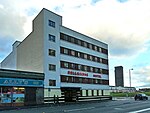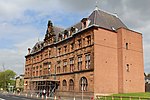Glasgow Bellgrove rail accident
On 6 March 1989, two Class 303 commuter trains crashed on the Springburn branch of the North Clyde Line, just east of Bellgrove station in the East End of Glasgow, Scotland. Driver Mr. Hugh Kennan, aged 62 of Maryhill, and passenger Mr. Robert McCaffrey, aged 58, a retired rail worker from Scotstoun, died in the crash and 53 people were injured.The accident was of a type known as "ding-ding, and away". It was caused primarily by a signal passed at danger (SPAD) in conjunction with the single-lead junction track layout, where two lines converged into one just beyond the platform end and then diverged again – a layout which is simpler to maintain but is vulnerable in the event of a SPAD. This type of junction has been implicated in other accidents, notably to the south-east of Glasgow in the Newton rail accident just a couple of years later. Both trains were travelling at 40 mph (65 km/h), so the collision speed was 80 mph (130 km/h). The force of the impact was so severe that at least one passenger was thrown out of his seat and completely destroyed one of the "A" frame back-to-back seats. An official report, delivered in May 1990, determined that the Milngavie-to-Springburn train had passed the signal at danger, causing a collision with the Springburn-to-Milngavie service.
Excerpt from the Wikipedia article Glasgow Bellgrove rail accident (License: CC BY-SA 3.0, Authors).Glasgow Bellgrove rail accident
Bellfield Street Footbridge, Glasgow Gallowgate
Geographical coordinates (GPS) Address Nearby Places Show on map
Geographical coordinates (GPS)
| Latitude | Longitude |
|---|---|
| N 55.856388888889 ° | E -4.22 ° |
Address
Bellfield Street Footbridge
Bellfield Street Footbridge
G31 1RL Glasgow, Gallowgate
Scotland, United Kingdom
Open on Google Maps








